This
month marks 12 months of baking breads together in the We Knead To Bake Group and given that’s it’s also a
season when there’s a lot of festive baking done in parts of the country and
the world, Aparna, the founder of this Baking group, thought we could also bake something special this month.
month marks 12 months of baking breads together in the We Knead To Bake Group and given that’s it’s also a
season when there’s a lot of festive baking done in parts of the country and
the world, Aparna, the founder of this Baking group, thought we could also bake something special this month.
The choice for this month is the Bienenstich Kuchen or what’s also known as the
German Bee Sting Cake! Bienenstich is not really a bread but a traditional
German sweet yeasted cake that has a baked on topping of crunchy almond toffee-like
layer and filled with a vanilla pastry cream.
German Bee Sting Cake! Bienenstich is not really a bread but a traditional
German sweet yeasted cake that has a baked on topping of crunchy almond toffee-like
layer and filled with a vanilla pastry cream.
Bienenstich is traditionally
eaten as dessert and also served with tea or coffee,
eaten as dessert and also served with tea or coffee,
Bienenstich
means “bee sting” in German and probably got its name from the honey flavoured
topping that it typical of this yeasted cake. There are however some
interesting stories connected to it. One story is that the German baker who was
creating this recipe came across a bee (possibly attracted by the honey) and
was stung by it and decided to name the cake after the incident!
means “bee sting” in German and probably got its name from the honey flavoured
topping that it typical of this yeasted cake. There are however some
interesting stories connected to it. One story is that the German baker who was
creating this recipe came across a bee (possibly attracted by the honey) and
was stung by it and decided to name the cake after the incident!
Another
story is that a group of German bakers stopped invaders from entering a neighbouring
village, sometime in the 15th century,
by throwing beehives at them. IN order to celebrate their victory, they
created the original version of the Bienenstich.
story is that a group of German bakers stopped invaders from entering a neighbouring
village, sometime in the 15th century,
by throwing beehives at them. IN order to celebrate their victory, they
created the original version of the Bienenstich.
The
Bienenstich is made with enriched brioche-like dough that’s typical for yeasted
cakes which means that it contains a lot of butter, some milk and eggs.I have left out the egg and added 1/4 cup of milk to knead the dough.
Bienenstich is made with enriched brioche-like dough that’s typical for yeasted
cakes which means that it contains a lot of butter, some milk and eggs.I have left out the egg and added 1/4 cup of milk to knead the dough.
You
may also like to use buttercream, Bavarian Cream or Diplomat Cream for the filling. The cake is a bit heavy so the filling should not be runny or too soft or it
will not be able to carry the weight of the upper cake layer. You can also add
fruit (strawberry, kiwi, mango, etc) to your “cream” layer even though this is
not traditional.
may also like to use buttercream, Bavarian Cream or Diplomat Cream for the filling. The cake is a bit heavy so the filling should not be runny or too soft or it
will not be able to carry the weight of the upper cake layer. You can also add
fruit (strawberry, kiwi, mango, etc) to your “cream” layer even though this is
not traditional.
One
of the problems of this yeasted cake is making sure the filling is strong
enough to take the weight of the upper layer. The other problem is cutting the
Bienenstich into slices or squares without the filling squishing out ad making
a mess of everything.
of the problems of this yeasted cake is making sure the filling is strong
enough to take the weight of the upper layer. The other problem is cutting the
Bienenstich into slices or squares without the filling squishing out ad making
a mess of everything.
The
first problem can be taken care of by using a filling that will hold up and not
using too much filling. The whipped cream can be stabilized with cornstarch (or
agar or gelatin if you use it). You can always thing the remaining fillng and
serve it with the Bienestich as a sauce.
first problem can be taken care of by using a filling that will hold up and not
using too much filling. The whipped cream can be stabilized with cornstarch (or
agar or gelatin if you use it). You can always thing the remaining fillng and
serve it with the Bienestich as a sauce.
The
second problem can be taken care of by placing the lower layer of the cake on
the serving plate and then making e a collar around it with a double layer of
parchment paper that should be a little taller than the height of your finished
Bienenstich. Now spread the filling over
the lower layer evenly.
second problem can be taken care of by placing the lower layer of the cake on
the serving plate and then making e a collar around it with a double layer of
parchment paper that should be a little taller than the height of your finished
Bienenstich. Now spread the filling over
the lower layer evenly.
Then
pre-cut your upper almond toffee layer into slices or squares depending on the
shape of your Bienenstich. Now place the slices/ squares on top of the filling
so it looks like the top layer is whole. Refrigerate this for at least a couple
of hours before serving. When ready to serve, remove the parchment collar, and
use the slices/ squares as a guide and cut through the filling right to the
bottom.
pre-cut your upper almond toffee layer into slices or squares depending on the
shape of your Bienenstich. Now place the slices/ squares on top of the filling
so it looks like the top layer is whole. Refrigerate this for at least a couple
of hours before serving. When ready to serve, remove the parchment collar, and
use the slices/ squares as a guide and cut through the filling right to the
bottom.
Bienenstich
Kuchen (German Bee Sting Cake)
Kuchen (German Bee Sting Cake)
Recipe Source : My Diverse Kitchen
Ingredients:
For the Pastry
Cream Filling:
Cream Filling:
250ml milk
3 tbsp sugar
3 tbsp vanilla flavoured custard powder
200ml cream
1 tbsp corn-starch
For the Dough:
1/2 cup milk
100gm butter, at room temperature
2 cups all-purpose flour
2 tbsp sugar
3/4 tsp salt
1 1/4 tsp instant yeast
For the Honey-Almond
Topping:
Topping:
50 gm butter
1/3 cup sugar
2 tbsp honey
1 tsp vanilla extract
1/2 cup almonds
Make the custard
for the filling first.
for the filling first.
This can be made the previous day and refrigerated till required.
Keep aside 1/4 cup of milk, and put the
remaining milk and the sugar in pan. Over medium heat, bring this to a boil
while stirring frequently to dissolve the sugar. In the meanwhile, dissolve the
custard powder in the 1/4 cup of milk. Add this in a stream, to the boiling
milk and keep whisking so that no lumps are formed.
remaining milk and the sugar in pan. Over medium heat, bring this to a boil
while stirring frequently to dissolve the sugar. In the meanwhile, dissolve the
custard powder in the 1/4 cup of milk. Add this in a stream, to the boiling
milk and keep whisking so that no lumps are formed.
Keep whisking until the custard becomes
very thick. Take the pan off the heat and let the custard cool to room
temperature. Whisk it on and off so it stays smooth. If it does become lumpy
after cooling, use a hand blender to make it smooth. Transfer to a bowl, cover
and refrigerate.
very thick. Take the pan off the heat and let the custard cool to room
temperature. Whisk it on and off so it stays smooth. If it does become lumpy
after cooling, use a hand blender to make it smooth. Transfer to a bowl, cover
and refrigerate.
Once you are ready to fill the Bienenstich, whip 200ml of cream till soft peaks form. Then add the corn-starch and whip till it forms stiff peaks. Whisk the custard to make sure it is smooth. Gently fold the cream into the custard. If you feel it is too soft, refrigerate for a couple of hours and then use.
For the Dough…
Heat the 1/4 cup of milk until it is quite hot but not boiling. Cut the butter into pieces and add to the milk, stirring it until the better melts completely. Let it cool a little.
In the meanwhile, put the flour, sugar, salt and the yeast in the bowl of your processor. Run a couple of times to mix well.
Now add the butter-milk mixture (it should be warm, not hot) and the then knead till it forms a smooth and soft (loose) brioche-like dough that’s just short of sticky.Add the other 1/4 cup and knead well. It should come way from the sides of the bowl and be easy to handle.
Shape the dough into a ball and place it in a bowl. Cover loosely and let it rise for about 1 1/2 to 2 hours. This dough will rise quite well but not to double or as much as the regular bread dough.
Prepare the
topping while the dough rises.
- Put the almonds into boiling water[should be off the stove and should not be cooked/ boiled].After 5 minutes, drain and
rinse once in cold water. Strain well. The skins of the almonds should feel a
little loose and look wrinkled now. Pinch each almond at the broad end with
thumb and forefinger and the skin should slip off easily. - Let
the almonds dry out on a kitchen towel in an airy place for about half an hour.
Then lay each almond down on its flat side and, using a sharp knife, slice as
thinly as you can and keep aside. - Melt the butter, sugar, honey and vanilla in a small pan,
over medium heat. - Keep stirring frequently and it will start bubbling up.
- Let
it cook for about 3 minutes or so until it turns to a light beige colour. - Add
the sliced almonds, and stir well till the almonds are well coated. - Take the
pan off the heat and let it cool a bit. The mixture will become quite thick.
- After the first rise,deflate the dough, and shape again to a
smooth ball. - Place it in a 8” cake tin lined with parchment. It is
important to do this otherwise the topping will make the bread/ cake sticky and
difficult to unmould. - Flatten the dough a little, pressing down lightly so that
the dough fits the cake tin. - It doesn’t matter if its not touching the sides
like batter does. - Let it rise for about 30 to 45 minutes. It will not rise very
much and look a little puffy. - Once the dough has risen, use a spoon
take bits if the topping (it will be quite thick, like a sticky fudge) and
distribute it uniformly over the surface. If there are small gaps they will get
covered once the bread/ cake is baking.
Bake at 180C (350F) for about 25 to 35
minutes until the top is golden brown and bubbling. A cake tester through the
centre should come out clean. Let the cake cool in the pan for about 15
minutes. Then gently loosen the sides with a spatula and unmould. Let it cool
completely on a rack.
minutes until the top is golden brown and bubbling. A cake tester through the
centre should come out clean. Let the cake cool in the pan for about 15
minutes. Then gently loosen the sides with a spatula and unmould. Let it cool
completely on a rack.
When it has cooled completely, slice the
cake into two equal layers carefully, using a very sharp knife.
cake into two equal layers carefully, using a very sharp knife.
Cut the almond toffee layers into slices.Spread the pastry cream on the lower layer and top with the pre-cut upper layer.
Refrigerate till ready to serve.
Note:
- The cake did not rise well. It looked like 2 pizza bases were stacked one over the other. I am not sure why it did not rise thought I followed the procedure to the T! But the texture was good!
- I had half of the filling left over! And it was not really thick as it should have been.
But whatever went wrong, it sure did not affect the taste of this lovely cake / bread.
Here are the other bakes that are a part of this Bake- A – Thon group….
document.write(”);
Bon Appetit…

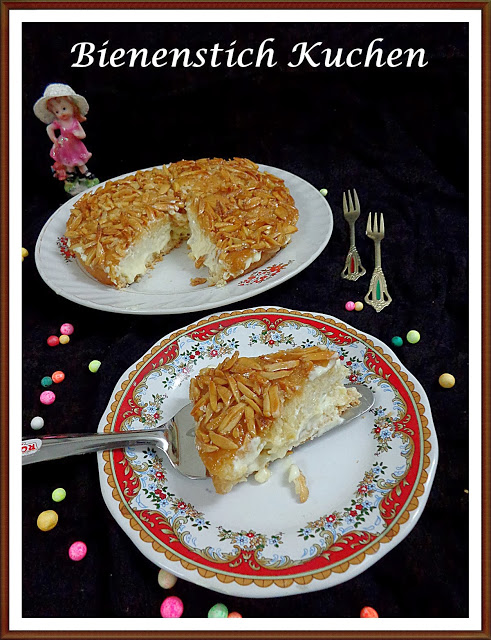
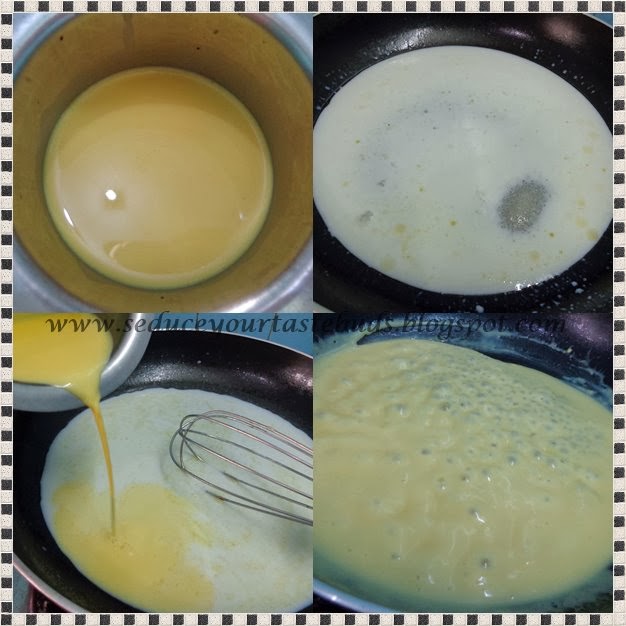
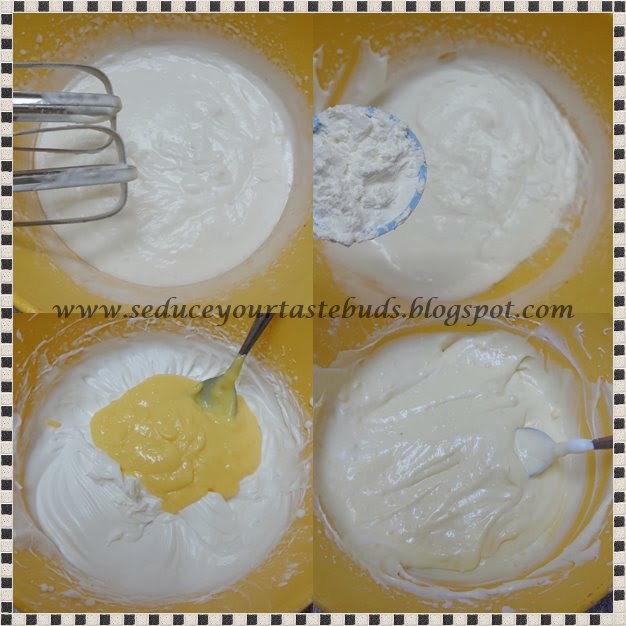
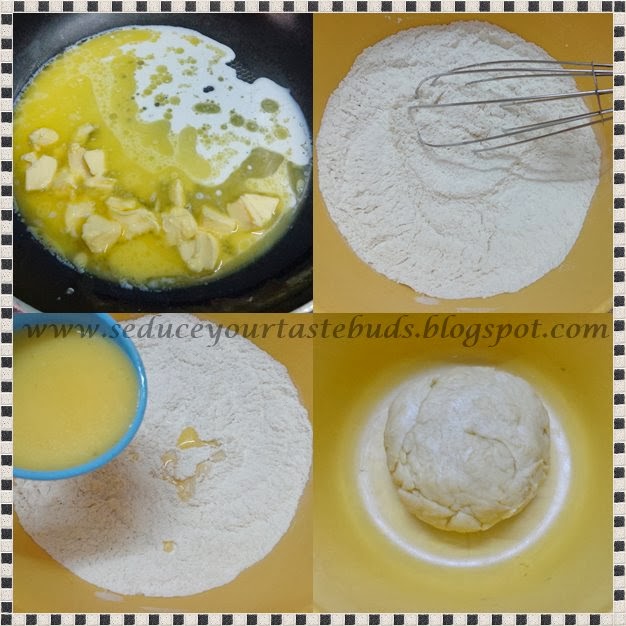




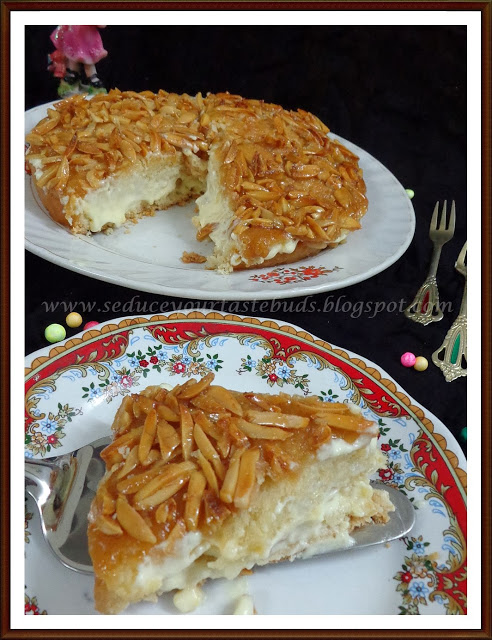

Wow the cake sounds good but so complicated..:)..I won't mind you making it for me..
This is a far richer variety of Bienenstich Kuchen than I remember from my German friends kaffeetrinken sessions! Theirs was more bread-like. I think I like your version much better! Just lovely and so rich!
soft and creamy cake. Looks super delicious.